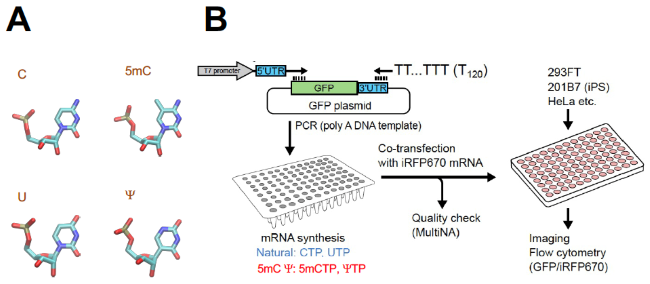In latest years, messenger RNA—the DNA’s close relative in the complex process of turning a string of genetic blueprints into a properly functioning organism—has gotten a lot of attention in the scientific and medical community. This is because of the potential role it could play in developing next-generation vaccines, cancer treatments, and stem cell therapies to treat a variety of earlier incurable diseases.
 Experimental approaches. A, example of chemically modified nucleotides used in this work is shown to the right. Shown to the left are the natural nucleotide, cytosine (C), or uridine (U) before modification. B, experimental scheme. See legends to Fig. 1A-B of the original paper. Image Credit: Katsura Asano, Hiroshima University and Kansas State University
Experimental approaches. A, example of chemically modified nucleotides used in this work is shown to the right. Shown to the left are the natural nucleotide, cytosine (C), or uridine (U) before modification. B, experimental scheme. See legends to Fig. 1A-B of the original paper. Image Credit: Katsura Asano, Hiroshima University and Kansas State University
Following the race to find a sort of vaccine that could eliminate COVID-19-related deaths, the previously esoteric issue of mRNA became an almost ubiquitous household utterance. Pfizer’s mRNA COVID-19 vaccine is the outcome of a tremendous effort by the scientific community, and vaccines with similar modes of action are on the way from other U.S. and global pharmaceutical businesses.
Professor Katsura Asano from Hiroshima University’s Graduate School of Integrated Sciences for Life in Japan, along with Kansas State University in the United States, directed an international research group to come up with new ways to unnaturally stimulate mRNA to react in ways that could ultimately lead to treatment interventions.
The researchers also focused on building on the success of the mRNA-based COVID-19 vaccines and providing new potentials across a wide range of possible genetic treatments.
Chemical modification is a biochemical process that brings a chemical mark to RNA bases, correlating to a genetic letter of life’s blueprint, and Asano and his fellow researchers discovered that such chemical marks both pace up and slow down the action in the emergence of the chemical zippers associated in generating gene-specific proteins. On April 8, 2022, researchers reported their findings in Science Advances.
The AUG Start Codon, a universal code for the genetic “zipper” of RNA, is used to activate mRNA in the protein creation process in animals, particularly humans. AUG is made up of methionine, an amino acid that is one of the twenty building blocks of protein structures.
Other RNA codons, such as GUG (amino acid Valine), UUG (amino acid Leucine), and CUG (also Leucine), are called “non-start” codons, which means they are less probable to signify the commencement of gene translation. They emerge instead in the center of the protein-coding region, which is responsible for unzipping the genetic blueprint and producing a specific protein.
Few other codons have been found to activate mRNA in the same way that AUG does. However, Asano and his team seek to change that by analyzing the effects of common RNA chemical changes on several types of uncommon start codons that initiate the translation process.
To do so, researchers used their prior observation that GUG, UUG, and CUG codons that vary from AUG by one letter are changed to a relatively strong start codon indicating methionine by adding the best RNA sequence for starting their translation event in animals.
Their research compared the efficiency of a dozen RNA sequences obtained from these sequences for producing green fluorescent proteins through various non-AUG start codons. Researchers employed flow cytometry to assess fluorescence from ~10,000 cells per linked RNA sequence and start codon to precisely evaluate GFP expression. They were able to compare the translation efficiency of natural RNA with chemically modified RNA in this way.
They discovered consistent patterns in how translation efficiency changed when a non-AUG start codon was given a specific chemical label. The potential of U-to-Psi (pseudouridine) transformation to greatly increase the initiation potentials of CUG, GUG, and UUG start codons, they noted, was a stunning breakthrough (and more satisfyingly no effect on AUG).
Chemical modification of non-AUG start codons can greatly alter initiation frequencies from these codons. Computer simulation played a key role in understanding the mechanism leading to these effects. mRNA translation from non-AUG start codons is an old but new concept. These start codons were used in prokaryotes [bacteria] but our research takes the concept a big step further by highlighting the possibilities of doing so in eukaryotes, including humans.”
Katsura Asano, Professor, Graduate School of Integrated Sciences for Life in Japan, Hiroshima University
Asano believes that the medical sector will keep track of this new body of evidence and continue to investigate ways to use chemically modified RNA to generate synthetic expression switches—to promote translation activity in humans and animals in a highly focused manner.
I am hoping that the companies making mRNA vaccines will use our findings. For example, they could use the UUG start codon and chemically modify mRNA by 1m Psi, as Pfizer did with their COVID-19 vaccine. They will allow strong expression of the antigen from the start codon and yet avoid protein expression from cDNA made and integrated into the genome by chance.”
Katsura Asano, Professor, Graduate School of Integrated Sciences for Life in Japan, Hiroshima University
Asano went on to say that no substantial dangers associated with long-term usage of any mRNA vaccines have been detected so far.
“But there is a small chance that vaccines against retroviruses make vaccine cDNA when the patient encounters these viruses during immunization. If this integrates into the patient’s genome, the antigen may be expressed in a way that attenuates vaccine production for boosting,” he concluded. “But beyond that, the concept is so easy and adds no extra cost. So we hope these techniques are adopted.”
Source:
Journal reference:
Fujita, Y., et al. (2022) Translational recoding by chemical modification of non-AUG start codon ribonucleotide bases. Science Advances. doi.org/10.1126/sciadv.abm8501.